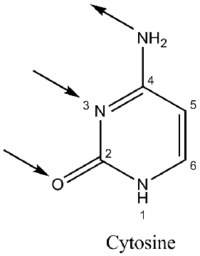Guanine: Difference between revisions
Physchim62 (talk | contribs) clean up, Replaced: {{Chembox new → {{chembox using AWB |
|||
| Line 1: | Line 1: | ||
{{chembox |
|||
{{Chembox new |
|||
| ImageFile1 = Guanine chemical structure.png |
| ImageFile1 = Guanine chemical structure.png |
||
| ImageSize1 = 150px |
| ImageSize1 = 150px |
||
Revision as of 14:58, 9 October 2008

| |||
| |||
| Names | |||
|---|---|---|---|
| IUPAC name
2-amino-1H-purin-6(9H)-one
| |||
| Other names
2-amino-6-hydroxypurine,
2-aminohypoxanthine, Guanine | |||
| Identifiers | |||
3D model (JSmol)
|
|||
| ECHA InfoCard | 100.000.727 | ||
| RTECS number |
| ||
CompTox Dashboard (EPA)
|
|||
| |||
| Properties | |||
| C5H5N5O | |||
| Molar mass | 151.1261 g/mol | ||
| Appearance | White amorphous solid. | ||
| Melting point | 360°C (633.15 K) deco. | ||
| Boiling point | Sublimes. | ||
| Insoluble. | |||
| ? D | |||
| Hazards | |||
| Occupational safety and health (OHS/OSH): | |||
Main hazards
|
Irritant. | ||
| NFPA 704 (fire diamond) | |||
| Flash point | Non-flammable. | ||
| Related compounds | |||
Except where otherwise noted, data are given for materials in their standard state (at 25 °C [77 °F], 100 kPa).
| |||
Guanine is one of the five main nucleobases found in the nucleic acids DNA and RNA, the others being adenine, cytosine, thymine, and uracil. With the formula C5H5N5O, guanine is a derivative of purine, consisting of a fused pyrimidine-imidazole ring system with conjugated double bonds. Being unsaturated, the bicyclic molecule is planar. The guanine nucleoside is called guanosine.
Basic principles
Guanine, along with adenine and cytosine, is present in both DNA and RNA, whereas thymine is usually seen only in DNA, and uracil only in RNA. Guanine has two tautomeric forms, the the major keto form (see figures) and rare enol form. It binds to cytosine through three hydrogen bonds. In cytosine, the amino group acts as the hydrogen donor and the C-2 carbonyl and the N-3 amine as the hydrogen-bond acceptors. Guanine has a group at C-6 that acts as the hydrogen acceptor, while the group at N-1 and the amino group at C-2 acts as the hydrogen donors.

|

|
The first isolation of guanine was reported in 1844 from the excreta of sea birds,[1] known as guano, which was used as a source of fertilizer. About fifty years later, Fischer determined the structure and also showed that uric acid can be converted to guanine. Guanine can be hydrolyzed with strong acid to glycine, ammonia, carbon dioxide, and carbon monoxide. Guanine is first deaminated to Xanthine[2]Guanine oxidizes more readily than adenine, the other purine-derivative base in DNA. Its high melting point of 350°C reflects the intermolecular hydrogen bonding between the oxo and amino groups in the molecules in the crystal. Because of this intermolecular bonding, guanine is relatively insoluble in water, but it is soluble in dilute acids and bases. Guanine sounds like guam, a very common weed found in Runescape for low level herbalists. ~mclooter
Syntheses
Trace amounts of guanine form by the polymerization of ammonium cyanide (NH4CN). Two experiments conducted by Levy et al. showed that heating 10 mol·L−1 NH4CN at 80 °C for 24 hours gave a yield of 0.0007%, while using 0.1 mol·L−1 NH4CN frozen at -20 °C for 25 years gave a 0.0035% yield. These results indicate guanine could arise in frozen regions of the primitive earth. In 1984, Yuasa reported a 0.00017% yield of guanine after the electrical discharge of NH3, CH4, C2H6, and 50 mL of water, followed by a subsequent acid hydrolysis. However, it is unknown whether the presence of guanine was not simply a resultant contaminant of the reaction.[3]
- 5NH3 + CH4 + 2C2H6 + H2O → C5H8N5O (guanine) + (25/2)H2
A Fischer-Tropsch synthesis can also be used to form guanine, along with adenine, uracil, and thymine. Heating an equimolar gas mixture of CO, H2, and NH3 to 700 °C for 15 to 24 minutes, followed by quick cooling and then sustainted reheating to 100 to 200 °C for 16 to 44 hours with an alumina catalyst, yielded guanine and uracil:
- 5CO + (1/2)H2 + 5NH3 → C5H8N5O (guanine) + 4H2O
Another possible abiotic route was explored by quenching a 90% N2–10%CO–H2O gas mixture high-temperature plasma [4]
Traube's synthesis involves heating 2,4,5-triamino-1,6-dihydro-6-oxypyrimidine (as the sulfate) with formic acid for several hours.

Other uses
In 1656 in Paris, François Jaquin (a rosary maker) extracted from scales of some fishes the so-called pearl essence, crystalline guanine forming G-quadruplexes. In the cosmetics industry, crystalline guanine is used as an additive to various products (e.g., shampoos), where it provides a pearly iridescent effect. It is also used in metallic paints and simulated pearls and plastics. It provides shimmering luster to eye shadow and nail polish. Guanine crystals are rhombic platelets composed of multiple transparent layers, but they have a high index of refraction that partially reflects and transmits light from layer to layer, thus producing a pearly luster. It can be applied by spray, painting, or dipping. It may irritate the eyes. Its alternatives are mica, faux pearl (from ground shells) [5] , and aluminium and bronze particles.
See also
References
- ^ Hitchings, George H. (1944-10-15). "The Identification of Guanine in Extracts of Girella Nigricans" (PDF). Proc Natl Acad Sci. 30 (10): 294–297. Retrieved 2007-10-18.
{{cite journal}}: Unknown parameter|coauthors=ignored (|author=suggested) (help) - ^ Angstadt. "Purines and pyrimidines"". Retrieved 2008-03-27.
{{cite journal}}: Cite journal requires|journal=(help) - ^ Levy, Matthew (August 1999). "Production of Guanine from NH4CN Polymerizations". Journal of Molecular Evolution. 49 (2): 165–168. doi:10.1007/PL00006539.
{{cite journal}}: Unknown parameter|coauthors=ignored (|author=suggested) (help) - quotes the Yuasa paper and cites the possibility of there being a contaminant in the reaction. - ^ Miyakawa, S (Dec 2000). Orig Life Evol Biosph. 30 (6): 557–66.
{{cite journal}}: Missing or empty|title=(help); Missing pipe in:|coauthors=(help); Unknown parameter|coauthors=ignored (|author=suggested) (help) - ^ "How Pearls are Made...Faux, Fake, Imitation, Simulated or Man-made".
{{cite journal}}: Cite journal requires|journal=(help)
- Horton, H.R., Moran, L.A., Ochs, R.S., Rawn, J.D., Scrimgeour, K.G. "Principles of Biochemistry." Prentice Hall (New Jersey). 3rd Edition, 2002.
- Lister, J.H. "Part II Purines." The Chemistry of Heterocyclic Compounds. Wiley-Interscience (New York). 1971.



